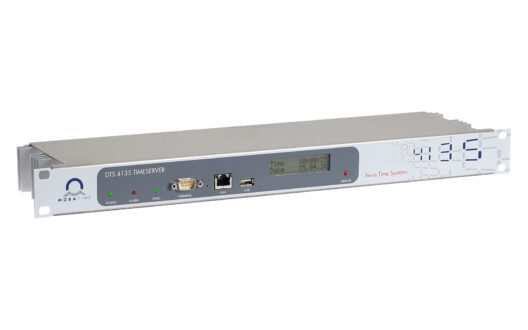NTP time server - DTS 4135
NTP time server - DTS 4135
DTS 4135 is a time reference for all NTP clients in medium and large networks (IPv4/IPv6). It is highly precise, and with its intelligent concept for redundant operation, it offers a high degree of reliability and availability.
| Oscillator type: | TCXO (DTS 4135) / OCXO (DTS 4136) |
|---|---|
| 1 LAN port (RJ45) / RPS: | provides NTP (< 3'000 requests/s) |
| Outputs: | 2x DCF/pulse/frequency output, 2x IRIG-B / AFNOR, 2x serial output, 1x DCF current loop output |
| High precision time: | Time reception from GPS |
| Redundancy: | master-slave operation with automatic switch over in case of an error |
| IP config | DHCP, static IPv4, IPv6 |
|---|---|
| Power supply | AC input: 90 to 240 VAC / 50 - 60 Hz / 0.25 A, 2 x DC input: 24 VDC +20 % / -10 % / 20 W |
| Accuracy | GPS (DCF input) to NTP server: typical < ± 100 µs / GPS (DCF input) to DCF 77 / pulse output: typical < ± 10 µs |
| Operation | Serial terminal via RS 232 (front side, sub-D 9p male) / Via LAN: MOBA-NMS, Telnet, SSH, SNMP |
| Time-keeping | Synchronized with GPS |
Leaflets
Manuals
Quick Installation
SNTP (Simple Network Time Protocol) and NTP (Network Time Protocol) are describing exactly the same network package format, the differences can be found in the way how a system deals with the content of these packages in order to synchronize its time. They are basically two different ways of how to deal with time synchronization.
While a full featured NTP server or -client reaches a very high level of accuracy and avoids abrupt timestamps as much as possible by using different mathematical and statistical methods and smooth clock speed adjustments, SNTP can only be recommended for simple applications, where the requirements for accuracy and reliability are not too demanding.
By disregarding drift values and using simplified ways of system clock adjustment methods (often simple time stepping), SNTP achieves only a low quality time synchronization when compared with a full NTP implementation. SNTP version 4 is defined in RFC2030, where it reads:
“It is strongly recommended that SNTP be used only at the extremities of the synchronization subnet. SNTP clients should operate only at the leaves (highest stratum) of the subnet and in configurations where no NTP or SNTP client is dependent on another SNTP client for synchronization. SNTP servers should operate only at the root (stratum 1) of the subnet and then only in configurations where no other source of synchronization other than a reliable radio or modem time service is available. The full degree of reliability ordinarily expected of primary servers is possible only using the redundant sources, diverse subnet paths and crafted algorithms of a full NTP implementation.”
Therefore the term “NTP time server” or “NTP compatible client” can – by definition – describe a system with a fully implemented NTP as well as any other product which uses and understands the NTP protocol but achieves far worse levels of reliability, accuracy and security.
If an internet connection is working properly then NTP can determine and account for the packet transmission delays quite reliable. However, if the internet connection is at its capacity limit, time synchronization can be significantly degraded due to high dispersion in packet transmission delays. Reasons for this may be hacker attacks, which must not address your own network, or new viruses causing a huge flood of emails, like it has already happened in the past. An own NTP server cannot easily be compromised out of the internet.
There are basically two ways to take the leap second into account in your own IT time system. The first solution (DTS4160, DTS4210) is that the leap second is automatically read in via the GPS receiver and the time server can implement this in the NTP time stamp that is output. The background to this device automatism is that the GPS satellite operators usually take the IERS specification into account accordingly, which is guaranteed by advance notice and the actual leap second itself. Only on the basis of both components can GPS receivers and time servers process the leap second correctly and at exactly the right time and also implement it in terms of system technology.
Some operators of critical infrastructures, on the other hand, prefer the manual procedure because there is a certain residual risk with regard to the secure reception of both of the above-mentioned components and the leap second usually has to be tracked separately for other IT systems anyway. Also, the definition of leap seconds is not a standard procedure, so that this may also speak for a conscious, then manual, process on the part of the user. With this alternative solution of manual setting, you can make a corresponding setting in good time with our DTS devices, for example via MOBA NMS or Telnet SSH, whereby the DTS time server then safely processes the leap second and implements it accordingly.
Typically it is < 1ms, when the network and the number of client requests per second is not taken into consideration.
The network delay can differ very much, depending on the traffic load. That’s why NTP packets contain two time stamps (packet output and packet input). So the response time can be calculated and compensated.
Conclusion:
For standard NTP, the network delay (response time) is not relevant for the precision of the client synchronization.
Except, when the delay should be very high, then the reachability of the NTP server could be degraded.





